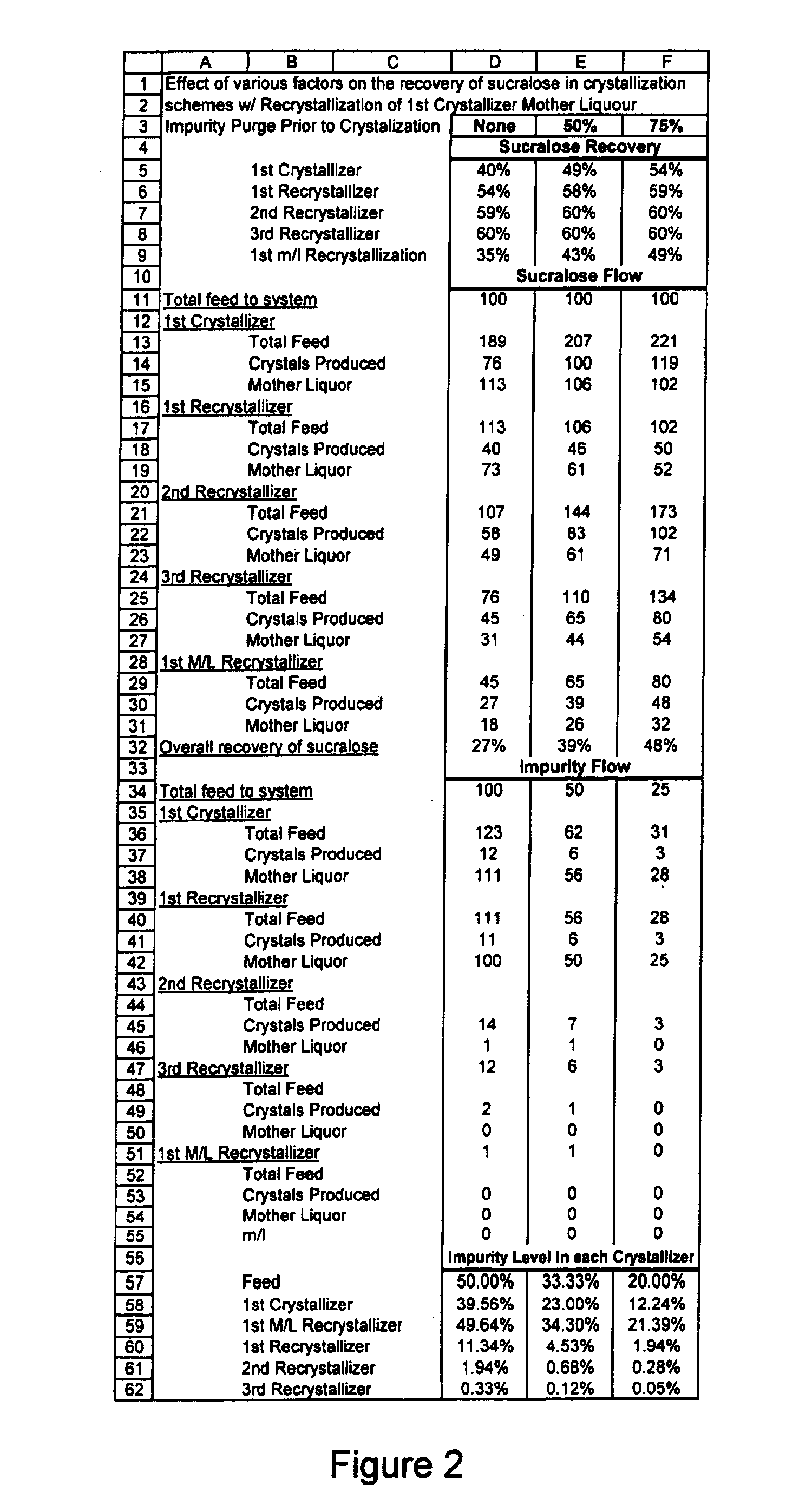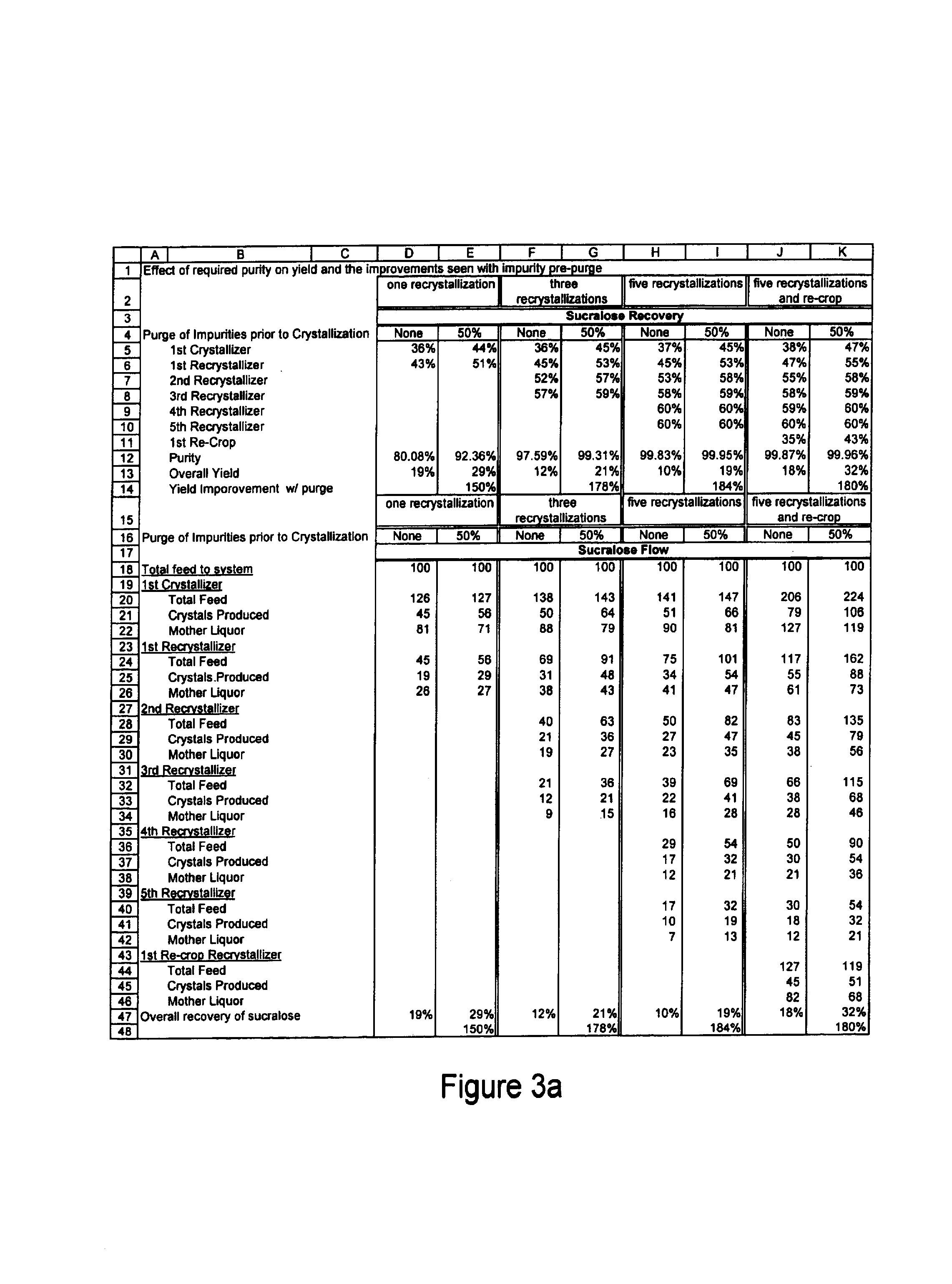Process for improving sucralose purity and yield
a technology of purification process and sucralose, which is applied in the field of purification process of sucralose, can solve the problems of difficult synthesis of sucralose, inability to meet the requirements of large-scale commercial production of highly pure sucralose, and inability to isolate sucralose in highly pure form from this complex mixture of contaminants. achieve the effects of improving yield, high purity and high yield
- Summary
- Abstract
- Description
- Claims
- Application Information
AI Technical Summary
Benefits of technology
Problems solved by technology
Method used
Image
Examples
example 1
[0099]Extraction was combined with crystallization and chromatography to produce a high purity sucralose. Intermediate streams of lower purity were returned to earlier steps in the process to enhance performance as to yield and purity. An initial extraction step produced a discarded aqueous phase and passed a solvent phase forward for crystallization. The non-crystalline portion of the first crystallization was first transferred to an aqueous medium and repurified via chromatography and returned to the feed to the extraction system, thereby purging undesirable materials. An initial aqueous crystallization similarly returned an uncrystallized portion to the same extraction system. Subsequent crystallizations returned their uncrystallized mother liquors to the prior crystallizer. This general scheme has been illustrated in FIG. 7.
Extraction
[0100]Feed streams from prior steps in the process (e.g., the synthetic process), the simulated moving bed (SMB) chromatographic purification, and ...
example 2
[0108]FIGS. 10a–10c present data demonstrating the effects of impurity levels on sucralose crystallization. FIG. 10a presents data from a continuous process crystallization apparatus in which the impurity level of the solution in the apparatus was plotted versus the sucralose remaining in the mother liquor (i.e., the sucralose that was not converted to a crystalline state). This plot shows that the level of sucralose in the mother liquor increased with the impurity level, demonstrating the inhibitory effect of impurities on crystallization. FIG. 10b presents another analysis of these data, again showing that increasing levels of impurities caused a decrease in the crystallization of sucralose. Finally, FIG. 10c shows the effects of impurity levels on the yield from crystallization. Increasing impurity levels over the range of 5% to 14% (weight / weight of solution) had a dramatic effect on the total yield of sucralose from crystallization. As discussed in detail above, FIGS. 1, 2 and ...
example 3
[0109]Purified sucralose is prepared by the process of solvent-solvent extraction and sequential recrystallizations as shown in examples 1 and 2 of the present invention. Next the taste of the resultant composition is tested in a beverage.
[0110]Sucralose solutions are prepared by adding crystalline sucralose to a model soft drink composition that contains 0.14% citric acid and 0.04% trisodium phosphate. The pH of this composition is 3.2. Crystalline sucralose compositions are added to the soft drink composition to yield final levels of 100 parts per million (ppm).
[0111]Panelists are selected from the general population, and no specific demographic parameters are utilized in recruiting the panelists. The product samples are prepared and served chilled. Portions are dispensed into individual servings for the panelists. Samples are presented to panelists in a blinded manner (samples are identified only by a random digit label). Each panelist receives three samples for tasting (one samp...
PUM
| Property | Measurement | Unit |
|---|---|---|
| temperature | aaaaa | aaaaa |
| residence time | aaaaa | aaaaa |
| residence time | aaaaa | aaaaa |
Abstract
Description
Claims
Application Information
 Login to View More
Login to View More - R&D
- Intellectual Property
- Life Sciences
- Materials
- Tech Scout
- Unparalleled Data Quality
- Higher Quality Content
- 60% Fewer Hallucinations
Browse by: Latest US Patents, China's latest patents, Technical Efficacy Thesaurus, Application Domain, Technology Topic, Popular Technical Reports.
© 2025 PatSnap. All rights reserved.Legal|Privacy policy|Modern Slavery Act Transparency Statement|Sitemap|About US| Contact US: help@patsnap.com



